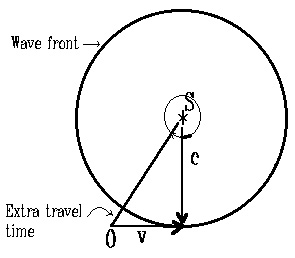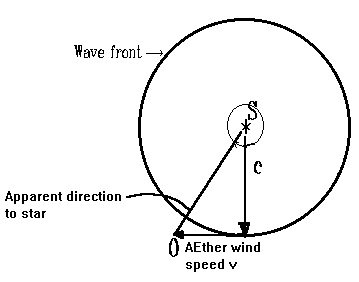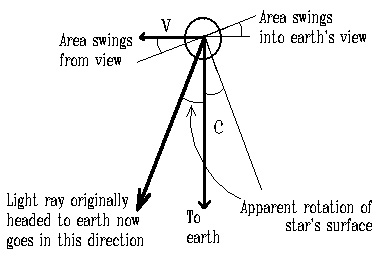In the last issue we published Walter van der Kamp's reasoning for claiming that the universe is small: that aberration of starlight is due to the parallax of stars at the edge of a small universe. In this issue I shall endeavor to show how this interpretation of aberration cannot be correct. Furthermore, I claim that no one really understands aberration at all. There are no fewer than four explanations, each physical, each based on experiment, accounting for aberration. Of the four, two coexist, namely Fresnell drag and relativity. A third, vector addition, is superseded by relativity, but it is by no means disproven. The fourth is having the light bearing medium, (a universal aether or possibly the gravitational or electro-magnetic field of the sun or earth) dragging the light past the earth; and it is a variant of the Fresnell drag explanation.
Aberration is a difficult concept to understand. The demonstrations and explanations seem simple enough, but when all observations are considered, it is not so simple. If it were so easy to understand, why, for the last several years have the American anti-relativity crowd struggled with the explanation of aberration? It has been suggested that if the usual explanation for aberration is correct that then all street lights should show aberration, and that said aberration should be large enough to make a hunter miss a distant target. Some have flatly stated that all fundamental, physical experiments show the earth to be absolutely at rest in the universe. With the latter I can heartily agree, but that does not solve the problem of aberration.
Raindrops and Stovepipes
For those readers new to the issue, an explanation of aberration is in order. The most common analogy used to describe aberration is that of a man, in the rain, with a stove pipe in his hand. The object is not to have raindrops hit the sides of the stove pipe. Clearly, if there is no wind and the man is standing still, then the stove pipe must be held vertically upright for the drops to fall through unimpeded. If our man starts to walk, then he must tilt the pipe into the direction he is walking in order to keep the walls free of raindrops. This latter is the same if the wind starts to blow from that direction and our man remains still. When we extrapolate our raindrop analogy to light, we find that we must point our telescopes forward in the direction of the earth's orbit about the sun in order to see a distant star. This, for years, was regarded as proof of the revolution of the earth about the sun, although it was tacitly recognized that the same phenomenon would also happen if the light-bearing medium were to sweep like a wind past the earth. It is the wind analogy which leads to missed targets and aberration of street lights.
Airy's Failure
In 1871, George Biddel Airy filled a telescope tube with water and looked to see if the angle of aberration changed. Would he have to point the telescope further into the direction of the earth's motion, or would it remain the same as without water? It turned out that the addition of the water did not change the amount by which the telescope had to be tilted in the earth's orbital direction in order to see the star. Originally, this experiment had been proposed by Ruggiero Guiseppe Boscovich (1711- 1787) as a potential proof for the Copernican model. Boscovich reasoned that the water-filled telescope must have to be tilted further forward in order to receive the light rays which would have been slowed down by the water.
In the early nineteenth century, a physicist named Fresnell noticed
that a narrow beam of light, shining straight through a plane of glass,
would hit a point directly below the source, but if the glass were moving,
the point where the light hit would be deflected in the direction of motion.
This effect is commonly known as “Fresnell drag.” Airy knew of
Fresnell drag, and on its basis he reasoned that the water would make no
difference, that the aberration angle would remain the same; and that is
indeed what he found. In Airy's experiment, the speed of light is slowed
by the water in both the vertical AND HORIZONTAL directions by the
same amount (n, the index of refraction). Hence the incidence angle
remains the same. Instead of the apparent position of the star changing,
what changes is the time it takes for the light ray to travel the length of
the telescope tube (given the speed of light is constant through the
medium). Picture This
What is really happening when we observe aberration, and why is it
so little understood? Part of the problem stems from scientific arrogance,
and part from fear of the unknown. After all, the observations reek of
geocentricity.
First of all, it behooves us to look at the situation from the
heliocentric perspective because this is the point of view familiar to most.
Figure 1 presents that view. As the light ray, c, travels to the earth, the
earth moves along with a velocity, v. From vector addition it follows that
the two velocities add together in such a way that the light seems to come
from the direction SO. Regardless of the explanation, this is what is observed.
In the heliocentric model there are two common explanations for the
effect. First of all, the length of the telescope tube may have been foreshortened
by the Fitzgerald contraction which shortens rulers as they
move faster and faster through space. This is the explanation which
relativity affords. Secondly, the water in the telescope tube may have
dragged the light beam along with it as the water orbits the sun, so that
there is no aberration. This is the Fresnell drag effect which Airy expected
to find. Since both of these phenomena have been “observed,”
which one applies?
The geocentric model affords similar explanations, the main difference
is that in the geocentric view the light-bearing medium
(commonly called the “aether”) flows past the earth rather than the earth
flowing through it. Both Fitzgerald contraction and Fresnell drag could
apply in the geocentric explanation, too. Figure 2 presents the geocentric
explanation for aberration. In one respect the geocentric view is more
realistic than the heliocentric view because the geocentric model assumes
the presence of the light-bearing medium whereas the relativistic
heliocentric model does not. This leads to a paradoxical situation in
relativity, for according to relativity, the speed of light is a scalar. The
word “scalar” is a technical term meaning that light travels at some speed
(that is, it has a “magnitude”), but it has no sense of direction (that is, the
speed of light is the same everywhere, regardless of the direction of
travel). But for Figures 1 and 2 to work, the speed of light has to be a
vector, not a scalar. In that sense, the geocentric explanation is better, albeit
similar.
The Problem Is…
If we take the strict relativistic view of the geocentric explanation, we
run into a problem. Instead of the aberration angle increasing as the
speed of the star past the earth increases, what we see instead appears as a
rotation of the star (Figure 3). A similar analysis has been done for the
non-relativistic case, and it is not that difficult to see. The light ray
which hits the earth will still appear to come straight from the star. Does
this cause a severe problem for the geocentric model? In no way. What
the analysis does is to require the presence of an aether for the geocentric
model. If there is a light-bearing medium, then the aberration angle is
defined by the flow of the medium, not by the relative motion of star and
earth; and the problem is solved.
Now it may be objected that science in general and relativity in particular
have “proven” that there is no aether. This is actually not the case.
The truth is that all materials drag light to some degree. This is because
the speed of light is different through different materials. Light travels
fastest through the vacuum of space and travels slower through glass and
water. One could even go so far as to say that the speed of light is zero
through a substance which absorbs light (e.g., black paint). So the air
drags light along with it just as do water and glass, acting just like an
aether even if there were no aether.
Could aberration be due solely to the air? Not likely, but it could
originate at the edge of the earth's gravitational field. More likely, the
Fresnell drag of the gravitational or electro-magnetic field of the sun and
the earth could account for the aberration just as well. Experiments such
at Sagnac's and the Michelson Gale experiment2
indicate the presence of
an aether by demonstrating that there is a relative rotation of earth and
aether (although experiments cannot tell if the earth rotates inside the
aether or if the aether rotates around the earth). The Sagnac experiment
has not been done to sufficient accuracy to show if the rotational period
of the aether is a solar day (24 hours) or a sidereal (stellar) day of 23
hours 56 minutes. If the former then it is more likely that aberration is
due to the earth's fields whereas if the latter then the universe's field is
more likely. Right now such experiments are considered in the same
light as was Boscovich's eighteenth century proposal for a light-filled
telescope: the conclusion is deemed foregone.
The Parallax Problem
It is significant that the moon, streetlights, and artificial satellites do
not exhibit aberration. Any source of light originating inside the earth's
gravitational field does not exhibit aberration. This may mean that aberration
originates at the edges of gravitational fields, for the sun and
planets do exhibit aberration.3 That the sun and planets exhibit aberration
present us with the proof against Walter van der Kamp's thesis that aberration
is actually a parallax. If Walter's interpretation is correct, the
planets and the sun should not participate in the 20”.496 aberration because
they are too close to the earth. Since they do, Walter's model
requires the planets and the sun all to be 58 light-days from the earth, the
same distance as the stars. This runs afoul of all evidence, including the
U.S.A. and former U.S.S.R.'s space programs unless, of course, one
wants to claim some grand conspiracy on the part of scientists and engineers
around the world. I know of no such conspiracy, nor any reason
to suspect one.
There is another, lesser problem with Walter's model. Unless the
stars were all exactly the same distance from earth, there will be slight
differences in their parallax. Indeed, such differences are detected. The
problem is that the differences are 90-degrees out of phase with aberration.
In other words, if aberration were a parallax, and if, for example, it
were pointing in the general direction of the constellation Pisces, then the
differences in parallaxes resulting from slight differences in distance
would also be in the direction of Pisces or, if further away than the
reference stars, in the opposite direction, namely to Virgo. If, on the
other hand, aberration is due to a form of Fresnell drag, then the parallax
due to differences in the stars distances should be at right angles to it. In
other words, if aberration is in the direction of Pisces then parallax will
be in the Scorpius-Gemini direction. It is the latter which is observed,
not the former.
The bible that is developed by the antichrist will be applauded as fully in
keeping with the high tech age. Further, New Age citizens will be told
that New Age scriptures can be changed when ever new scientific discoveries
suggest revisions are needed.
— Texe Marrs, Dark Secrets of the New Age, p. 193.
1 2 3
Interestingly, no one prior to Airy had performed Boscovich's experiment
because all “knew” that the angle of aberration would be increased
because, “As every idiot knows,” the earth goes around the sun. Why
waste time and money on an experiment whose conclusion is beyond
doubt?1 Airy's failure to detect the added aberration is called “Airy's
Failure,” which makes it sound bad for Airy, but he saw what he expected
so it was a success and not a failure.

FIGURE 1: Heliocentric aberration explanation.

FIGURE 2: Geocentric aether-wind aberration explanation.
FIGURE 3: How aberration at the source amounts to an apparent
rotation
In conclusion, although we conclude that the true nature of stellar
aberration is not really understood, there is enough evidence to conclude
that aberration cannot be interpreted as a parallax and, thus, as evidence
for a small universe.